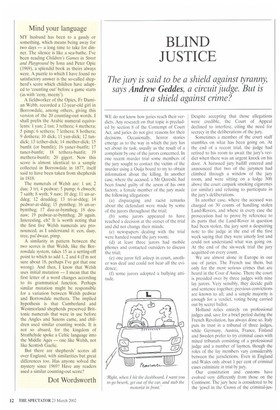Mind your language
MY husband has been to a gaudy or something, which means being away for two days — a long time to take for dinner. The silence is like a sea-bathe. I've been reading Children's Games in Street and Playground by Iona and Peter Opie (1969), a splendid book as theirs always were. A puzzle to which I have found no satisfactory answer is the so-called shepherd's score which children have adapted to 'counting out' before a game starts (as with `eeny, meeny').
A fieldworker of the Opies, Fr Damian Webb, recorded a 12-year-old girl in Borrowdale, among others, giving this version of the 20 counting-out words. I shall prefix the Arabic numeral equivalents: 1 yan; 2 tan; 3 tethera; 4 methera; 5 pimp; 6 sethera; 7 lethera; 8 hothera; 9 dothera; 10 dick; 11 yan-dick; 12 tandick; 13 tether-dick; 14 mether-dick; 15 bunfit (or bumfit); 16 yaner-bunfit: 17 taner-bunfit; 18 tethera-bunfit; 19 methera-bunfit; 20 gigert. Now this score is almost identical to a sample collected in Borrowdale in 1877, itself said to have been taken from shepherds in 1818.
The numerals of Welsh are: 1 un; 2 dau: 3 tri; 4 pedwar; 5 pump; 6 chweeh; 7 saith; 8 wyth; 9 flaw; 10 deg; 11 un-arddeg; 12 deuddeg; 13 tri-ar-ddeg; 14 pedwar-ar-ddeg; 15 pyrntheg; 16 un-arbymtheg; 17 dau-ar-bymtheg; 18 deunaw; 19 pedwar-ar-bymtheg; 20 ugain. Interesting, eh? It is worth noting that the first five Welsh numerals are pronounced, as I understand it; een, daay, tree, pai'dwaar, pimp.
A similarity in pattern between the two scores is that Welsh, like the Borrowdale system, takes 15 as a setting-off point to which to add 1, 2 and 4 (I'm not sure about 18, perhaps I've got that one wrong). And then, I know that Welsh uses initial mutation — I mean that the first letter of a word changes according to its grammatical function. Perhaps similar mutation might be responsible for a variation between Welsh pedwar and Borrowdale methera. The implied hypothesis is that Cumberland and Westmorland shepherds preserved Brittonic numerals that were in use before the Angles and Saxons came, and children used similar counting words. It is not so absurd, for the kingdom of Strathclyde spoke a Celtic language into the Middle Ages — one like Welsh, not like Scottish Gaelic.
But there are shepherds' scores all over England, with similarities but great differences too. Has anyone solved the mystery since 1969? Have any readers used a similar counting-out score?
Dot Wordsworth


















































































 Previous page
Previous page